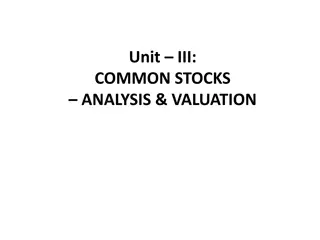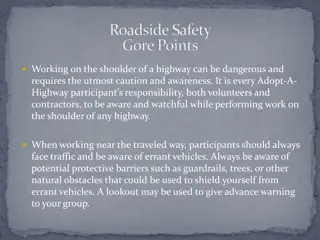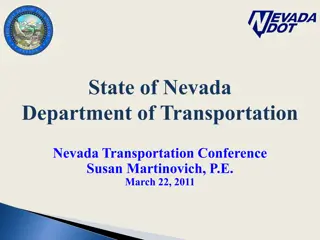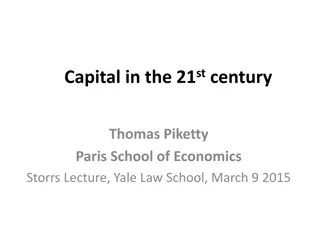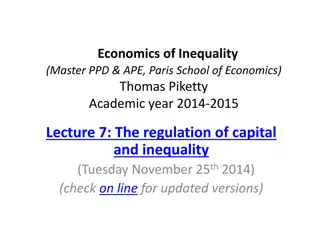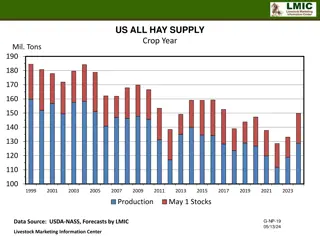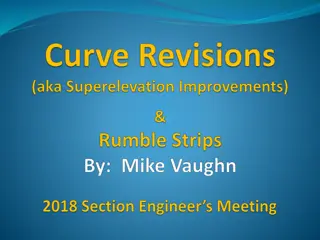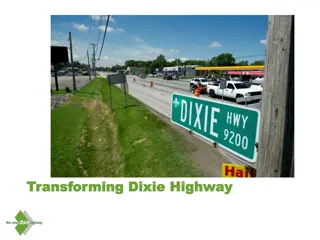Detailed Analysis of Highway and Street Wealth Stocks
This research evaluates the impact of detailed capital outlays and alternative depreciation methods on highway and street wealth stocks. It compares official BEA data with alternate BEA research, providing insights into investment, depreciation, and net wealth capital stocks for the transportation sector.
Download Presentation

Please find below an Image/Link to download the presentation.
The content on the website is provided AS IS for your information and personal use only. It may not be sold, licensed, or shared on other websites without obtaining consent from the author.If you encounter any issues during the download, it is possible that the publisher has removed the file from their server.
You are allowed to download the files provided on this website for personal or commercial use, subject to the condition that they are used lawfully. All files are the property of their respective owners.
The content on the website is provided AS IS for your information and personal use only. It may not be sold, licensed, or shared on other websites without obtaining consent from the author.
E N D
Presentation Transcript
Constructing BEA Highways and Streets Net Wealth Stocks with Constructing BEA Highways and Streets Net Wealth Stocks with Detailed Types of Investment and Engineering Detailed Types of Investment and Engineering- -based Estimates of Depreciation of Depreciation based Estimates Authors: Barbara M. Fraumeni, Central University of Finance and Economics, Beijing, China & National Bureau of Economic Research Robert Kornfeld, U.S. Bureau of Economic Analysis Discussant: Eve Smith, Assistant Deputy Director, Non-Financial Assets, ONS
Introduction Objective: Objective: Evaluate the impact of using detailed capital outlays and alternative depreciation methods on highway and street wealth stocks. Official BEA Official BEA: The FAAs (official BEA) provide annual estimates of fixed investment, economic depreciation and net wealth capital stocks for highways and streets and over 100 other government and private fixed assets. The FAAs provide highways and streets publicly available data in current- and constant-prices from 1901 (investment) or 1925 (wealth stocks and CFC) to the present. Alternate BEA Research: Alternate BEA Research: Kornfeld and Fraumeni (2022) disaggregated highway investment into detailed types. Current Paper: Current Paper: Presents two further scenarios: The substitution of Picher-based pavement profiles for pavement rates of depreciation The introduction of varying imputed rates of geometric depreciation rates to the more detailed capital outlays
Official BEA and Alternative BEA Sources and Methodologies Official BEA Sources: Official BEA Sources: Annual estimates of fixed investment, economic depreciation, and net wealth capital stocks. o Publicly available data from 1901 (investment) or 1925 (wealth stocks and CFC). o Methodology: Methodology: Use of the Perpetual Inventory Method (PIM) o Same constant-price estimates of investment in all calculations o Assume a Geometric Pattern occurs o
Alternate BEA: Disaggregating Capital Outlays Table 1: Service Lives Assumptions and Geometric Rates Alternative BEA Paving Grading Bridgework Other structures Safety Traffic management Environment/other Official BEA Service life (years) 20 80 50 50 15 15 50 45 Geometric rate of depreciation .0455 .0114 .0182 .0182 .0607 .0607 .0182 .0202
Alternate BEA: Disaggregating Capital Outlays Figure 1: Shares of Capital Outlays, All Highways and Streets, 1921 2021 100% 90% 80% Environmental enhancement & other 70% Traffic operation & control systems 60% Safety 50% Other structures 40% Bridgework 30% Grading 20% 10% Paving 0% 1921 1926 1931 1936 1941 1946 1951 1956 1961 1966 1971 1976 1981 1986 1991 1996 2001 2006 2011 2016
New Scenario: Picher-based paving sources and methodology Picher estimated efficiency profiles for pavement with an assumed lifetime of 20 years, as contrasted with an infinite lifetime with a geometric rate of depreciation. Picher-based productive stock estimates were converted to wealth stock estimates to allow a comparison to the official BEA and alternative BEA wealth stocks. Productive stocks depend on the efficiency of an asset only in the current period, whereas wealth stocks depend on the efficiency of an asset in the current and all future periods. (Lightbulb example) Productive stocks are always greater than wealth stocks if the annual efficiency levels are the same, except in the special case of a geometric rate.
Comparison of Alternate BEA and Picher- based estimates
Comparison of Alternate BEA and Picher- based estimates
New Scenario: Varying geometric depreciation rates Analysis so far indicates official BEA geometric rate of depreciation for highways and streets is too low Challenges with using Picher-based approach on alternate BEA Data is not not available far enough back Picher type profiles would need to be constructed post 1986 Alternatively, could vary the official BEA geometric rates Two scenarios 1) imputed geometric rates are calculated by dividing alternative BEA depreciation by alternative BEA stocks 2) imputed geometric rates are calculated by dividing alternative BEA depreciation with Picher-type wealth profiles by alternative BEA stocks with Picher-type wealth profiles
Wealth Stocks with Imputed Geometric Rates Figure 9: Wealth Stock, Including with Imputed Geometric Rates, 1921-2021, millions of 2017 dollars
Conclusion Introducing a more detailed level of disaggregation of highways and streets BEA investment suggests that the official BEA geometric depreciation rate is too low. Whether or not the Picher-based estimates become the basis for pavement depreciation, a more disaggregated level of investment significantly reduces the level of wealth stocks. The authors ask whether geometric rates in the alternative scenario for the disaggregated components are the correct rates and which of the imputed geometric rates scenarios would be an appropriate basis for geometric rates.
Discussion Points In the world of National Accounts maintaining comparability with international guidance is important and how we translate the guidance. How sensitive is the PIM to parameter changes and how frequently should we be reviewing our assumptions including depreciation methods and the evidence on which we make those assumptions? This is covered in the 2022 paper, particularly when talking about incomplete data. Does the assets discussed in the paper have the appropriate profile as we can see how sensitive the PIM is to using a different profile. Does the profile reflect the economic reality of the asset? Transparency of our parameters and reasons for updating Other considerations is the disaggregation of assets to better inform asset lives estimates. Aggregation and risk of error (processing errors and time). How far do we go and what evidence are low level assumptions based on (low sample size)? Not specific to the paper, there is a broader question of how do we determine the most appropriate parameters for capital stocks each asset, not just depreciation profiles. Therefore, the evidence and choice of assumptions is key










